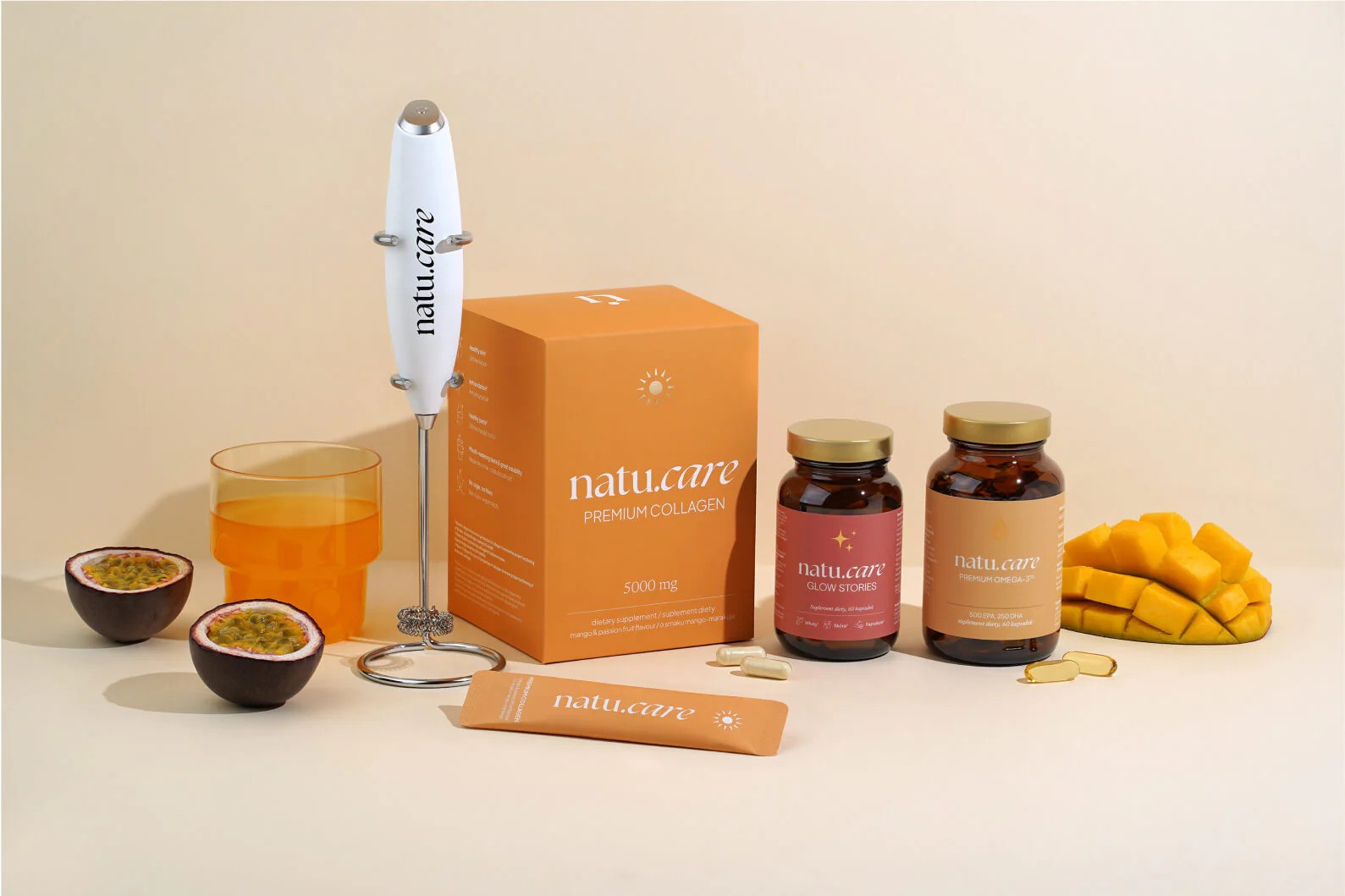Brand and Performance Campaigns Measurement – Natu.Care – Case Study
Text below is a summary of the presentation by Arkadiusz Wiśniewski and Bart Turczynski from E-commerce Growth Meetup 2024! Full video, where you can find this and other interesting presentations is available here!
What’s Natu.Care ?

One day she [Natalia Grajcar] decided that having ideally improved her quality of life, she would pursue this avenue and help others chase their health, wellness, and beauty goals.
Bart Turczynski, Head of Acquisition of Natu.Care
Natu.Care started offering products such as:
- collagen,
- a hair-nail-skin supplement,
- a sleep aid,
- vitamin D.
Since then, they’ve expanded their offerings to include:
- omega-3 fish oil,
- light-duty collagen,
- and they’ve got a few more products in the works.
Marketing Challenges
Natu.Care a resourceful startup, understands the critical role that every advertising dollar plays in their success. With limited funds, they cannot afford to gamble on marketing strategies. Instead, they are on a strategic journey to identify the most effective channels and tactics to maximize their return on investment (ROI).
Business Model
Natu.Care is building a brand that aims to help people meet their health, beauty, and wellness needs. They initially experimented with running a marketplace but eventually shut it down. They now focus on creating loyal fans of the Natu.Care brand, ideally interested in a subscription-based model.
Acquiring Customers
Natu.Care divided their marketing strategy into:
- Cold campaigns (aka prospecting; no prior interaction): Typically focus on the Middle of the Funnel (MOFU) or Top of the Funnel (TOFU), but with nuances—some might be Bottom of the Funnel (BOFU).
- Warm campaigns (aka remarketing; prior interaction): Typically focus on the Bottom of the Funnel (BOFU).
TOFU vs Brand Marketing vs #StartupLife
- They have to focus on direct, scalable sources of attributable revenue #StartupLife.
- They are accountable for every dollar, so they focus on driving sales.
- More general brand marketing is not for them.
The Problem: “Half the money I spend on advertising is wasted; the trouble is I don’t know which half.” – Conflicting Marketing Platforms

Bart’s frustration wasn’t unique. Conflicting data from advertising platforms like Google Ads and Meta created headaches for many, especially startups. The problem of “conversion duplication” inflated performance metrics, obscuring the real return on investment (ROI). It’s like pouring marketing dollars into a campaign that looks successful, only to find out later that the numbers were misleading.
But what is the conversion duplication?
A major issue with conventional marketing panels and platforms is that they count conversions as if other platforms don’t exist. This isolated approach often leads to inflated conversion counts, where the global total is higher than the actual number of unique conversions. Since each panel counts its data without considering overlaps with other platforms, this results in duplication and a distorted picture of campaign performance. This inconsistency complicates the task of businesses that need a clear, accurate view of their marketing outcomes.
The lack of reliable data hampered decision-making, making trustworthy insights as rare as unicorns in a desert. It became nearly impossible to optimize campaigns and allocate marketing budgets with confidence.
Discrepancy between Marketing Platform Metrics

Why Meta Ads Panel is not enough?
- Conversions are duplicated! You won’t get quality insights without defining how big impact every source had to encourage user to convert.
- You have only Meta Ads data there. It is not easy to compare results from different sources, especially with duplicated conversions!
- You know how your ad performed on Facebook/Instagram because of Impressions and CTR, but the rest of the journey is hard to understand.
- Different approach to user identification than Google Tools. This can make your decision process a guessing game!
Typically, businesses turn to marketing panels and platforms like Google Analytics 4 (GA4) as solutions for tracking and understanding their advertising performance. However, while these tools offer valuable insights, they often fall short of providing a complete and accurate picture. Their limitations, such as incomplete data and issues with tracking across multiple platforms, can lead to discrepancies and uncertainty in understanding the full customer journey. This gap underscores the need for more robust solutions that can overcome the inherent constraints of traditional marketing analytics.
Why GA4 is not enough?
- GA4 will deduplicate your conversions, but there is way more unpaid coversions in the panel!
- GA4 is working only on your site – you don’t know what happened with your ad before!
- Cookies aren’t imperishable! Especially, when your user use different devices to interact with your site.
The discussion highlighted a critical challenge: discrepancies in platform-reported metrics. Differing methodologies between Google Analytics 4 and Meta, create inconsistencies that hamper data-driven decision-making. They needed an unified platform that leverages transparent methodologies to deliver consistent, actionable insights. This clarity empowered them to make confident business decisions and drive true marketing success.
Working solution? First Party Attribution!

Sublime Analytics Platform offers a unified solution powered by first-party attribution, utilizing existing data sources to precisely reconstruct conversion paths. By integrating all touchpoints, including impressions, and addressing issues like duplicate conversions, Sublime provides a comprehensive and accurate assessment of marketing channel performance. This translates into actionable insights and empowers businesses to make informed decisions with confidence.
We are using web click information from Google Analytics 4, e-commerce data from Shopify, and downloading data from ad platforms like Meta, Google, and TikTok. We recreate conversion paths in a data warehouse.
Arkadiusz Wiśniewski, CEO & Co-founder of Sublime Analytics Platform
Main assumptions behind 1st-party attribution:
- Click-based on GA4 data to perform deduplication
- Tracking gaps filled with META Conversion API
- Ad impressions overlaid on conversion paths
First Party Attribution – Results of Three-Month Test

The results of the three-month test focused on evaluating the effectiveness of the first-party attribution model proposed by Sublime Analytics Platform in optimizing Natu.Care ‘s marketing spend. Here are more details about the results:
- The test involved collecting and analyzing data from various sources, including Google Analytics 4, Shopify, and ad platforms like Meta, Google, and TikTok.
- The results showed discrepancies between the data reported by advertising platforms and the first-party attribution model. Specifically, Natu.Care ‘s cold campaigns were found to be undervalued in platform reports compared to the first-party attribution model.
- The analysis revealed that Natu.Care ‘s cold campaigns were more effective than previously assumed based on platform-reported data.
The discrepancies highlighted by the first-party attribution model provided actionable insights for Natu.Care’s marketing strategy. By identifying the undervaluation of cold campaigns and other key performance indicators, Natu.Care could reallocate its marketing budget more effectively to maximize ROI.
Arkadiusz Wiśniewski, CEO & Co-founder of Sublime Analytics Platform
Future Challenges and Solutions
Following the three-month test results, the discussion addressed ongoing challenges in attribution modeling. A significant limitation is tracking users beyond a 28-day window, impacting long-term campaign assessments. Additionally, duplication issues between upper-funnel channels like Meta and TikTok complicate attribution accuracy. To overcome these hurdles, suggestions included implementing post-purchase user surveys to refine attribution models and using marketing mix models for a comprehensive understanding of marketing channel contributions.
Conclusion
While progress has been made with first-party attribution, challenges remain in refining marketing spend optimization strategies. The meeting concluded with an opportunity for questions and further discussion, emphasizing the need for ongoing refinement and collaboration in adapting to evolving consumer behaviors and technological landscapes.
Contents:
Contents:




